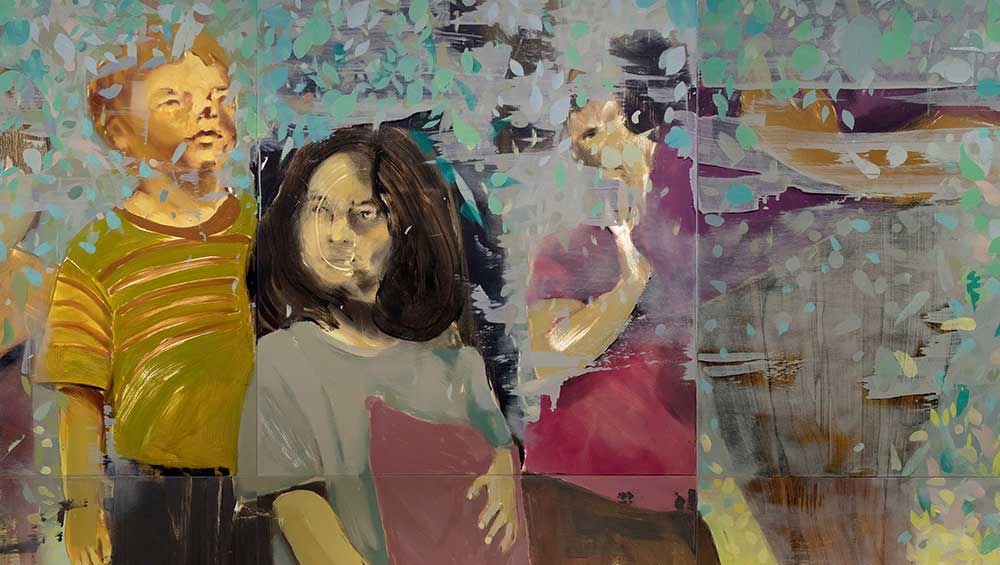
Bartosz Beda, Four Seasons, Fall, 2022-23 (detail). Oil on canvas, 96 x 108 in (244 x 274 cm). © The Artist.
by LILLY WEI
The painter Bartosz Beda was born in Poland in 1984, but moved to the UK in 2005 to study at Manchester School of Art, where he gained a BA and then an MA in fine arts. He moved to Dallas, Texas in 2018, where he now lives. The following is an edited and excerpted conversation between Beda and Lilly Wei about Echoes of Seasons, his current exhibition.
Lilly Wei: Would you talk a little about yourself and how your practice evolved?
Bartosz Beda: I always wanted to be an artist, following my older brother’s lead, copying his drawings and paintings as a child. I went to a high school specialising in fine arts in Poland, where I was born, and became interested in animation. Łódź, my hometown, is also the home of the Polish National Film School and called the Polish Hollywood (or HollyŁódź) because so many films were made there. Curious, I worked on productions that involved animation and stop motion, including Peter and the Wolf, which won quite a few awards, among them an Oscar for best animated short film in 2008.
LW: But you are a painter. When did you begin to make paintings?
BB: My true passion has always been painting. My foray into the world of animation was more of a detour. I felt that pursuing what I truly loved, which was painting, was a better choice, even though it had its share of challenges and uncertainties. I had a longstanding desire to study painting abroad, and in 2005, I went to England, to Manchester, choosing to go there for many reasons, one of them because I already had a basic knowledge of English.
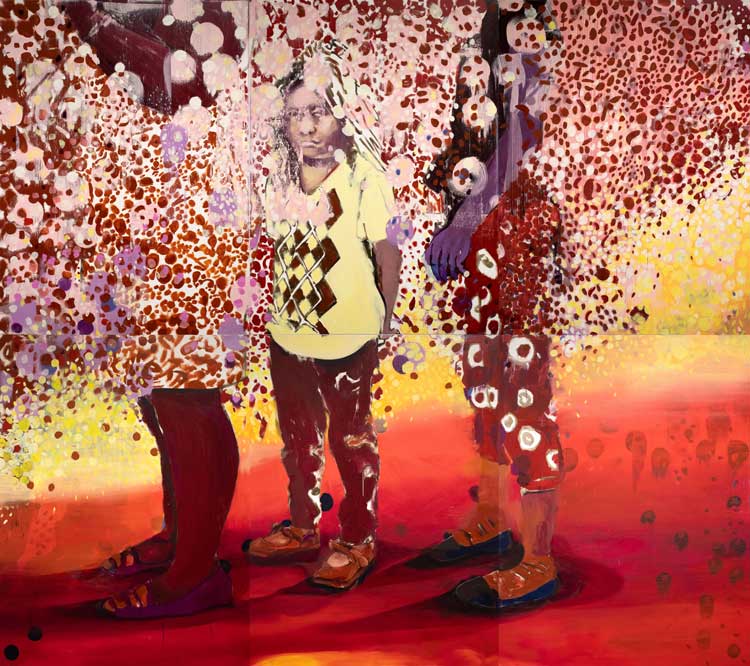
Bartosz Beda, Four Seasons, Spring, 2022-23. Oil on canvas, 96 x 108 in (244 x 274 cm). © The Artist.
LW: Your surfaces are so lively, so textured and richly worked. Would you talk a little about how you achieve that?
BB: In general, in all my works, I always look for different kinds of tools for my mark-making in addition to different kinds of brushes. That includes plastic wrap, squeegees, cardboard, much more. I might cut some shapes out of paper for a stencil and then place it on the canvas and paint over it, changing its placement, painting over it again, using it to create different patterns, different textures, what the painting needs. In chaos, there is always some kind of order.
LW: And you think of your style as both representational and abstract?
BB: I start the painting with an abstract image and from that, a figure emerges, depending on the theme I’m working on. I think of this as a perfect marriage, neither one overpowering the other, but harmoniously balanced. My paintings are clearly legible, but with enough abstract thinking to make the content less fixed, more encompassing.
LW: And scale?
BB: This show, Echoes of Seasons, allows me to show very big paintings because the space is so large. These paintings, though, are actually polyptychs, constructed from smaller works. I play with a variety of scales. I like making smaller paintings because they can be finished more quickly – a large one might take up to six months or longer to complete – but I also like to shift sizes because I don’t want to get used to just one size; I like the challenge. And, of course, the impact is different depending on the dimensions.
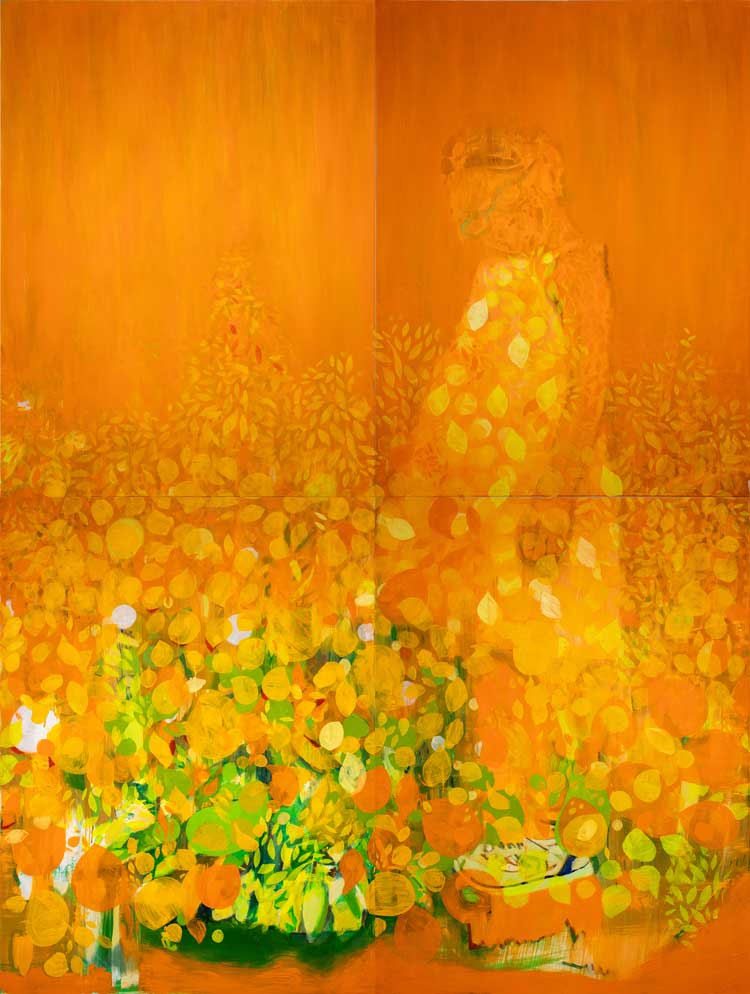
Bartosz Beda, Four Seasons, Spring, 2022-23. Oil on canvas, 96 x 72 in (244 x 182 cm). © The Artist.
LW: The way you treat the paint often partially obscures your images, makes them seem more mysterious, more elusive. Do you agree?
BB: I think that kind of obscuring is in every one of my paintings. It’s because the figures are not representing a specific person, they are not portraits. That generalising, that obscuring of the faces erases their individuality so you can read them through many lenses, read different personalities in them. It is also a stylistic decision; they are balanced between the abstract and the representational, more expressive than realistic, in the tradition of paintings like those of Francis Bacon or Lucian Freud, both of whom had an influence on me as a student.
LW: All the paintings in this show have children as the subject. Could you talk about that?
BB: At the end of 2020 to 2021, a lot of people were crossing the border between the US and Mexico; I live in Texas and am very aware of this – and also as an immigrant myself. At the border, children were separated from their parents and the parents sent back. That separation from their parents was a starting point to explore and develop on canvas. While it was about a traumatic situation, I also thought it had something to do with the seasons of our lives and the changes that occur in each, as we become who we become because of what happens to us. The early years of our lives are developmentally crucial and shape our character, our personalities, and events that take place in childhood can alter the core of our being. For the children who crossed the border, it was the kind of season in their lives that will change their future, that’s how I thought of it.
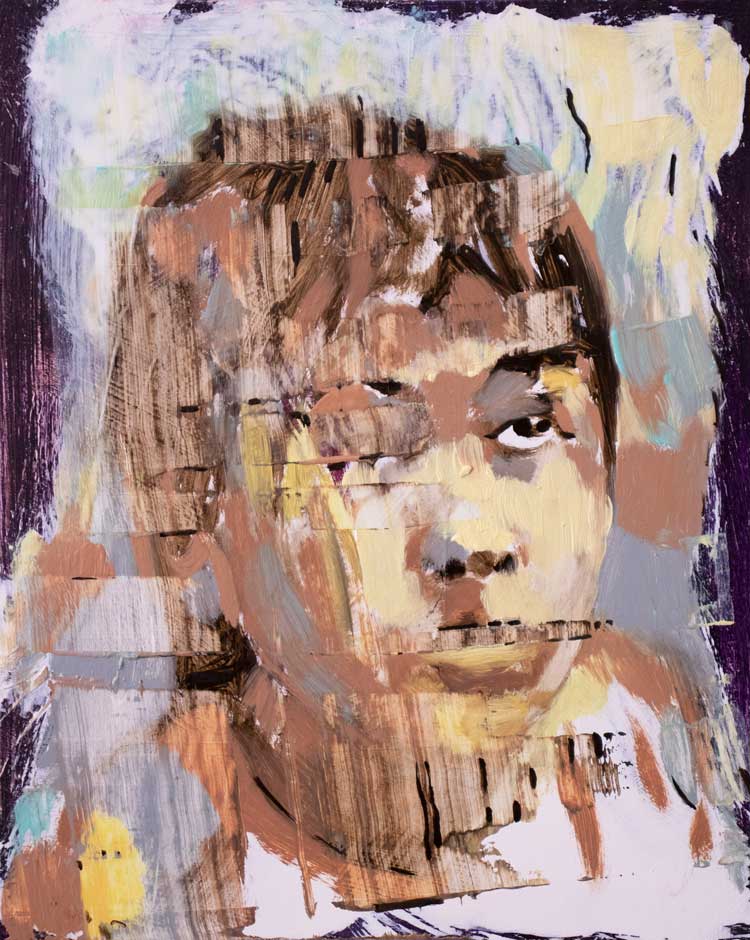
Bartosz Beda, Amalia, Fall, 2022. Oil on panel, 10 x 8 in (25 x 20 cm). © The Artist.
LW: You mentioned Freud and cake in comments elsewhere about your work. Would you talk a little about that?
BB: In thinking about seasons, I also thought about layerings. Freud kept a journal of the dreams of his patients and, in doing so, became aware that the subconscious was more complicated than most people realised. He thought of it as a layered chocolate cake as a way to visualise that, representing the conscious and unconscious mind. Cutting into that cake with its multiple layers, the overlay of traumas, of events that have impacted on our lives is revealed.
LW: Are you talking about life-shattering events then?
BB: No, no. They don’t just represent negative events, just events that come from all kinds of sources in one’s life, referring to the seasons of life metaphorically: spring, for instance, is joyful, with beginnings; summer is about bloom, ripeness; fall is perhaps a slowing down, preparing for death; winter is to sleep, replenish: the cycles of life. The border represents hope, then, and a better future, a better season, a starting point. The interpretation will vary for each viewer.
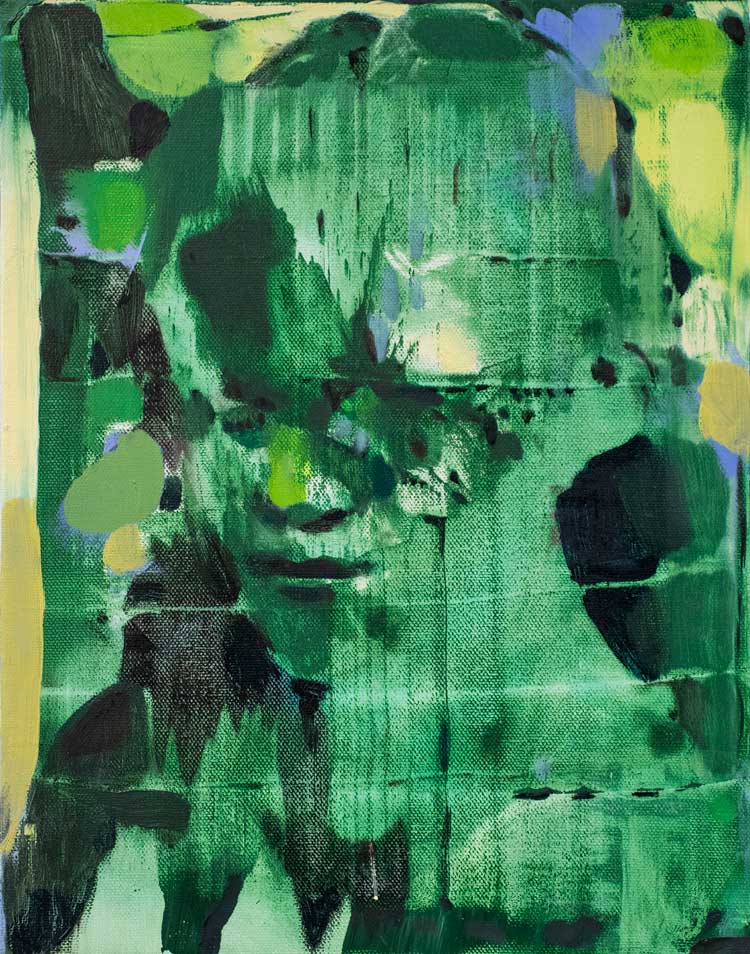
Bartosz Beda, Whispers of Echoes 03, 2023. Oil on canvas, 14 x 11 in (35 x 28 cm). © The Artist.
LW: You mention migration as a theme in your work. Would you talk about that a little?
BB: One thought I had about migration is this aspect of it. I was in an artists’ residency in Reading, Pennsylvania, which was ranked the poorest city in the US in 2011, the majority of its population Latino. When people migrate, they often don’t know the language of their new country, so they struggle to get jobs, even though many were highly educated professionals at home. I conceived of a project in which I sold the work I made for $7.25, the minimum hourly wage, to emphasise the difficulties of new immigrants. And there is another form of migration that I think about, that is more internal, meditative, as we retreat from our daily life into a more spiritual realm. And I think about the photos of children crossing the border, which is not just a current event but has other, metaphorical meanings that refer to the stages of our lives.
LW: Do you always work in series?
BB: I try to work in series because it’s easier to develop an idea. In a single work, it’s harder to explain.
LW: Would you talk about one work that perhaps best visualises your ideas?
BB: If I had to choose a single painting, I would pick the green one of children submerged by leaves. It is so abstract that it becomes a painting about painting, about colour, about mark-making. I like to forget about narratives and subject matter and enjoy the painting for itself, to see the process, the play of colours and their relationship to each other. In this body of work, it was the combining of four or more sections to make one big painting that was important to me.
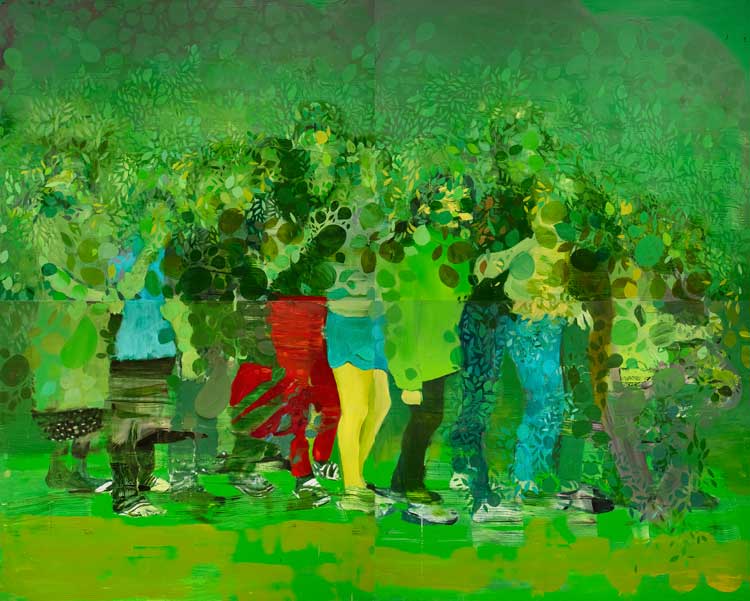
Bartosz Beda, Whispers, 2023. Oil on canvas, 96 x 120 in (244 x 304 cm). © The Artist.
I did that at first because it was easier to move the smaller canvases when working on them. But those four sections acquired symbolic meanings. They represented north, south, east and west, the four directions that symbolise the world. They took me back to my childhood when my mom made me go to church every day. The church had a beautiful altarpiece with wings that could open and close, and it also represented the world, as well as heaven and hell, and the seasons. The purpose of those paintings was to visualise the church’s doctrines, to deepen the faith of the devout, and while the symbols and stories have lost their meaning over the ages, they are still there.
LW: Would you talk a little about your influences?
BB: I mentioned Lucian Freud and Bacon, but Gerhard Richter was more of an influence. It wasn’t necessarily the paintings, but how he abandoned figurative painting to become an abstractionist. Many thought that was an ill-considered move, but he wanted to move on to something new, something different, to grow. For me, more and more over the years, the combining of the abstract and the representational makes sense. At this point, I’m not looking at other artists.
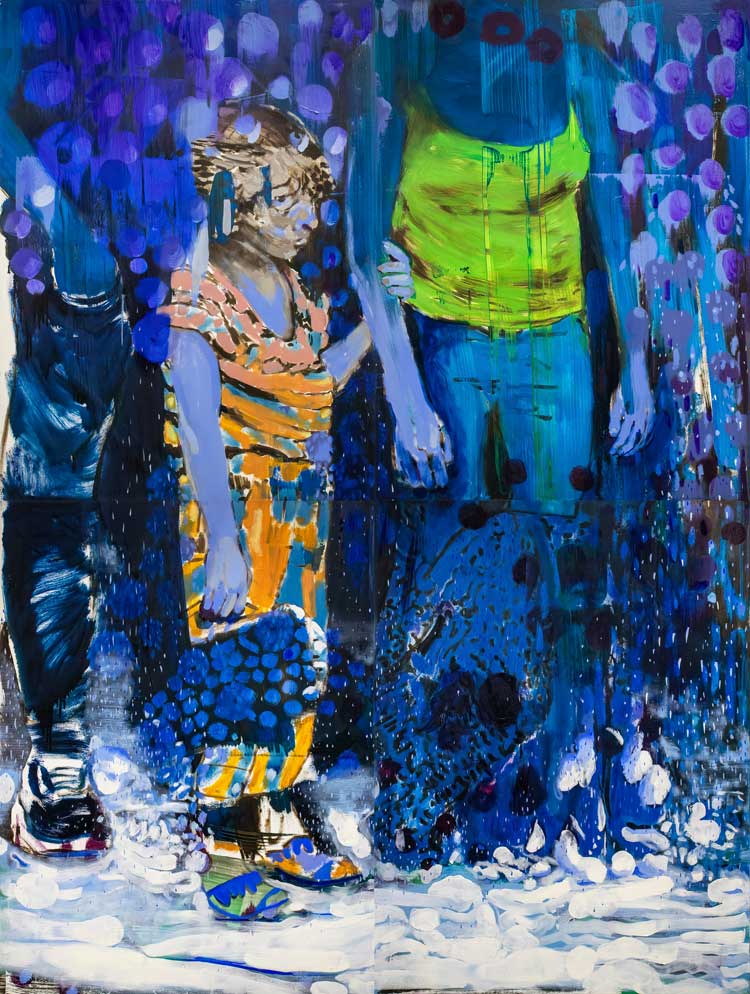
Bartosz Beda, Four Seasons, Winter, 2022-23. Oil on canvas, 96 x 72 in (244 x 182 cm). © The Artist.
LW: Could you talk about how you come up with your projects, what initiates them?
BB: It’s hard to say. If you’re not an artist, you might not think about the struggle that artists have in making their work. If you are an artist, you dismiss the struggle once the paintings leave the studio. But it is a struggle for me, and I’m sure for many artists, if not most. Once I finish the painting, I’m satisfied. But then, soon afterwards, I begin to think it’s not my best piece. How can I change it to make it better? These questions constantly come back to me, as it must for every artist. But if it weren’t for the struggle, maybe I wouldn’t go to the studio. I wouldn’t need to go.
Maybe because I am Polish, I am eastern European, that pessimism is part of my DNA; every century, at least, brought wars to Poland, brought unhappiness. Living in the UK and the US, there is a greater sense of optimism, but I wonder if the American dream still exists? For me, it’s a circle of thoughts, events; in the end, my paintings are autobiographical.
• Bartosz Beda’s solo show Echoes of Seasons is at the Art Gallery at Collin College, Texas, until 26 October.